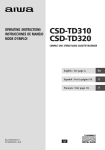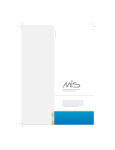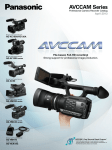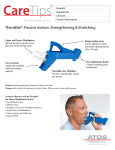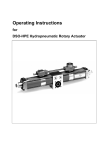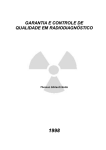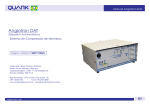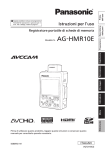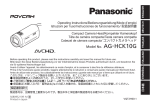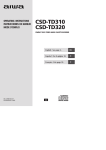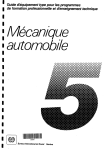Download User Manual - ROE Dental Laboratory
Transcript
MIS System Guide | 2010 ® User Manual © MIS Corporation. All Rights Reserved. Published by MIS, which reserves the right to modify the products described in this manual as well as to revise this publication at any time and without informing any person of such revision or change. All rights reserved. No part of this publication may be reproduced, transcribed, stored in an electronic retrieval system,translated to any language or computer language, or transmitted in any form whatsoever without the written consent of the publisher. Questions, comments or requests will be addressed promptly by contacting MIS specialists directly through our e-mailing address: [email protected]. MIS’ website can be accessed at www.mis-implants.com. This online site highlights current products and reflects all new discoveries and developments. Note: This User Manual is for educational use only. MIS Implants Technologies Ltd. produces an oral implant system that includes self-tapping dental implants in a wide range of sizes. These implants, currently being used successfully worldwide, provide a solution to partial and full edentulism. All implants go through gamma-irradiation and are supplied sterile in specially designed tubes. The implants are selftapping with threads designed to provide secure primary fixation and favorable distribution of the loading forces. The MIS Implants system is manufactured from titanium alloys. MIS Implants Technologies Ltd. is vigilant about maintaining the high quality of its products as well as developing new products in the fields of dental implants, abutments and surgical kit components. MIS’s Quality System complies with international quality standards: ISO 13485:2003 - Quality Management System for Medical Devices, ISO 9001: 2008 – Quality Management System and CE Directive for Medical Devices 93/42/EEC. MIS’s products are cleared for marketing in the USA and CE approved. Overview 6.Introduction 7. Raw Material 8. Finite Elements Test 10. Implant Treatment 11. Implant Surface Overview. MIS concept 13. Roughness Measurements 14. XPS Analysis 15. In Vitro Test 16.Histology 6. Overview Introduction MIS is a dynamic, high-tech research and production company. It develops and manufactures a comprehensive range of dental implants that provide long-lasting successful solutions to partial and full edentulism. The MIS Implants system combines several advantageous elements in order to achieve good primary stability and successful osseointegration. The qualities that contribute to successful osseointegration have been determined by various researchers to include: choice of raw material, macrostructure, microstructure and surface cleaning. In this chapter we present these factors and others that have been considered and/or included in the implants manufacturing process. MIS upholds its high standards, relevant to these factors, through comprehensive examinations and tests. The implant surface is tested and has satisfied or exceeded all requirements for implants. The tests are carried out in some of the world’s best-known research institutions. The main tests that MIS implants undergo are: - Mechanical test - XPS Analysis - Roughness - Surface analysis - SEM - Cytotoxicity - Sterility - Torque removal value - Histology Overview 7. Overview Raw Material All MIS implants are made of biocompatible medical grade Titanium alloy. Titanium and its alloys are highly successful materials for the fabrication of dental implants because of their favorable combination of properties such as; low specific weight, high strength to weight ratio, high modulus of elasticity, very high corrosion resistance and excellent general biocompatibility. The excellent biocompatibility and osseointegration capabilities of titanium are related to a variety of favorable properties of the material and its surface, including the following: the impedance and polarization resistance (Rp) values of the metals. SEM micrographs, and an equivalent circuit confirmed this behavior. Modification of the surface by thermal treatment improves corrosion resistance, as a protective titanium layer is formed on the surface. Another quality that makes titanium uniquely suited to implants is that the titanium oxide layer is stable over a very large range of physiologic pH, and therefore there is no release of free ions into the tissue. Titanium alloys increase the mechanical strength by 30%-40% over pure titanium. -A dense, highly resistant passive oxide film that protects the underlying metal from (further) oxidation and corrosion. -A very low dissolution rate of the oxide film and an extremely low concentration of charged titanium corrosion products. Biocompatibility is a complex property that involves physical, chemical, biological, medical and design aspects. It is important to note that the corrosion resistance of the titanium alloy is directly related to the surface condition before corrosion evaluation, and is a determining factor in the electrochemical behavior of this alloy. A study of titanium and its alloys, demonstrated that the biocompatibility of metal implants was related to their electrochemical characterization. The results showed that the presence of cells on metals led to an increase in Titanium alloys increase the mechanical strength by 30%-40% over pure titanium. 8. Overview Finite Elements Test The finite elements method (FEM) provides additional information about implants. Implants analysis by FEM is a test that is commonly used for the localization and prediction of a mechanical system failures. A structure analysis enables the determination of effects such as deformations, strains and stresses which are caused by applied structure loads. The safety factor is calculated using the maximum stress failure theory for ductile materials. The stress limit is specified by the tensile yield strength of the material. The benefits of FEM include increased accuracy, enhanced design and better insight into critical design parameters. The results of these tests show that the greatest stress occurs in the neck rather than the apex of the implant. MF4 MF7 Overview 10. Overview Implant Treatment Structure (Raw Material) Roughness (Macro & Micro) Titanium’s rough surface provides many points for mechanical anchorage and increases the envelope surface by two to three times. Subtraction Advantage: no degradation and separation of the coating. Sandblast The combination of the two methods induces macro and microstructure that is optimal for cell adhesion. Acid Etching MIS Surface Treatment Overview 11. Overview Implant Surface The contact surface of a dental implant is a very important aspect of the implant’s long-term success. This phenomenon is known as osseointegration. The opposing reaction of the bone to the implant is determined by morphology, chemical composition, load and the characteristics of the implant surface. It is achieved by topography and morphology, nano surface elements and bone reaction tests. SEM image of the bone-to-implant interface SEM image showing an osteoblast At MIS all of the following aspects have been considered: Macrostructure The geometric design of the body and thread profile of the implant act to increase the primary stability and to distribute the axial forces of occlusion. of 100 microns, and is in turn covered with an additional one-molecule-thick layer of contaminants containing sodium, silicon, magnesium, fluorine, etc. The cleaning process is multi- staged in order to ensure the quality of the product. The success of the implant is determined its geometric shape, by its microscopic texture and its surface quality. Microstructure The surface roughness and microgeometry of titanium are achieved by sandblasting and acid-etching. This process increases the surface envelope of the implant. Blasted surfaces demonstrate more bone to implant surface contact when compared with machined surfaces. *This advanced geometric design and surface morphology are the factors that create successful implants. Surface cleaning The implant surface consists of titanium oxide (Ti O2), which can reach a thickness x2000 x5000 Overview 13. Overview Roughness Measurements Roughness or rugosity is a measure of the small-scale variations in the height of a physical surface. A rough texture allows the trapping of different elements and increase the envelope surface. A high tendency for high roughness improves mechanical anchorage and increases the envelope surface by two to three times. AFM Test MIS Surface topography Roughness Measurement The arithmetic average of the deviation Ra is the most commonly used measure for surface roughness. The microgeometry of MIS implants meets the roughness recommended in the international literature. Instrument: Parthometer M1 (MAHR) Ra 2.2µm Rz 14.6µm Rmax 15µm Lt 5.6mm Lc 0.8mm Pc (0.5-0.5) 165/c 14. Overview XPS Analysis For surface analysis the samples were irradiated with monochromatic X-rays. Survey spectra were recorded with a pass energy of 100 eV, allowing the surface chemical composition to be determined. The atomic concentrations were calculated using elemental sensitivity factors, without applying any standardization procedure. The core level binding energies of the different peaks were normalized by setting the binding energy for the Cls to 284.5 eV. For each of the screws, one flat edge area, marked as #1, was analyzed in the as-received state only. Table 1 XPS Atomic Concentrations (%) for LOT 83 Implants MF7-13375, thread area 1 C Ti O 24.31 19.45 52.71 N - MF7-13375, thread area 2 27.78 16.11 51.31 0.21 Ca - Si S Cl Na Al Cu Mg - - 0.12 - 3.08 0.05 - - 0.78 3.60 - - P V - 0.33 - 0.16 Table 2 Ti Oxide Thickness (nm) for LOT 83 Samples Oxide Thickness (nm) MF7-13375, thread area 1 6.5 Table 1 XPS Atomic Concentrations (%) for LOT 41903 Implants MF7-13375, thread area 1 C Ti O N Ca 25.71 17.60 52.22 1.99 - Si S Cl - - - Na Al Cu Mg F P ZN - 1.96 - 0.51 - - - MF7-13375, thread area 2 28.66 14.88 52.62 0.84 - -- - - - 2.12 - 0.87 - - - * Instrument: VG Scientific Sigma Probe X-Ray Source: Monochromatic Al K&, 1486.6eV X-Ray Beam Size: 400 µm Interpretation of Results No strange elements or traces thereof were identified. This means that the surface treatment (etching) did not leave any undesired effects. The implants were classified as normal based on the C/Ti ratio. Overview Absorption of Serum Protein to Modified Titanium Surfaces 20 15 10 5 Albumin IGG Fibronectin Fibrinogen 0 MACHINE BIOCOM M.N. Sela, L.Badihi, G.Rosen D.Kohavi and D. Steinberg The use of Titanium (Ti) implants is a innovative clinical procedure in dentistry. The absorbtion of biological molecules to the implant’s surface triggers a sequence of events that can determine the outcome of this procedure. Clinical data suggests that modified Ti surfaces play an important role in the success or failure of the implant. Objective: the purpose of this study was to investigate the interaction between Ti implants with different surface properties and serum proteins, in order to find the optimal implant surfaces that may improve the osseointegration process and implant intake. Materials & Methods: Ti disks (6mm in diameter) with two types of surface modifications were compared: Machined and Sandblast together with Acid-Etched. The disks were coated with mixtures of Human Serum Albumin conjugated with fluorescein (HAS-FITC). Following incubation, the coat was removed from the disks by SDS. SEVEN A Confocal Scanning Laser Microscope was used to visualize and measure the HAS-FITC coat and the degree of protein removal from the Ti surfaces. Results: The Confocal Microscope images revealed a significantly higher amount of HASFITC coat on the rough disks, as compared with the machined disks. Furthermore, under similar experimental conditions, less HAS-FITC could be removed from the rough disks than from the machined disks. Conclusions: Absorption of albumin to the rough treated Ti surface is both qualitatively and quantitatively far more intense, as compared with the machined surfaces. Further studies of the chemical and physical characterization of the modified Ti surfaces are underway. Moreover, additional serum proteins, as well as oral microorganisms, are being examined for their interactions with the modified Ti surfaces. Hebrew University Jerusalem, Israel, IADR, August 03, 2004 16. Overview Histology MIS implants undergo routine testing, including histology and microsity tests, in order to evaluate the amount and quality of bone integrated on the implant as well as other indications for osseointegration. The osseointegration's success is determined through the many contact areas of the implant surface. The following report characterizes the MIS implant surface as indicated by the various test results. Light Microscopy Micro CT The sample was analyzed by micro CT before histological treatment was analyzed by micro CT. X-ray micro-computed tomography (SkyScan 1072, Belgium). The X-ray source was operated at 100 kV and a current of 98 µA. The sample was rotated 180° with a rotation step of 0.90°, an acquisition time of 5.6 s per scan and a pixel size of 11.8 µm. Three-dimensional reconstructions were then performed with the 3D Creator SkyScan software. Histology Embedding Samples were fixed in a 10% formalin solution, dehydrated in ascending graded ethanol (70, 80, 90, 95, 100%) and pure acetone, and then impregnated and embedded in PMMA (methyl methylmetacrylate). The Polymerization was obtained with a temperature increase from 20°C to 80°C. X-ray microtography Results and Discussion The histotology and microscopy results show the following osseointegration contact areas between the bone and implant surfaces: Light Microscopy Full osteointegration was observed. Bone contact was achieved both in the front of the wire and at the top of the implant. Bone ingrowth with bone trabeculae was also observed. Micro CT Bone osseointegration was observed along all the 3D axes. Bone trabeculae are directly in contact with the wires. Conclusion In conclusion, it appears that larger bone ingrowth and bone contact was observed in the implants. Overview Materials and Methods Implants 20. Implant System 22. UNO Implants. 30. BIOCOM 38. SEVEN 20. Implants Implant System The MIS leading implants: UNO, BIOCOM and SEVEN UNO ONE PIECE UNO NARROW BIOCOM SEVEN The innovative design of our implants, combined with our simple and fast insertion procedures, provides an easy to use system that ensures successful results. The wide range of MIS implant lines provides a variety of clinical solutions for the reconstruction of a single tooth, screw-retained or cemented fixed bridges, and overdentures. Furthermore, MIS Note: The selection of MIS implants and procedures is a recommendation only, and cannot replace the judgment and the experience of the surgeon. This recommedation shoud be used as a guide only. implants can be used in any surgical and bone augmentation procedures, from the simplest to the most intricate. MIS implants are made of highquality materials under very strict quality control procedures with a 100% inspection rate. All MIS implants are made of biocompatible medical-grade titanium, and their surfaces undergo dual-acid-etching procedures. Implants MIS has developed a range of unique implants and tools to assist in the simplification of the implantation process and to ensure both efficiency and success while minimizing risks. 22. Introduction Each of these unique implants is specifically engineered for use in narrow ridges and tight spaces. The insertion of the UNO implant is a quick and simple one-stage procedure. Due to their innovative geometries and advanced surface morphology, these unique implants offer high primary stability. These versatile implants can be used to restore single crowns and anterior cemented bridges. UNO NARROW UNO ONE PIECE 23. Implants One Piece Fixture - Technical Info 2.1mm 5º 5º 8 1 2.1mm 7(A) 2 0.6mm 7(B) 3 6 5 Length 2mm 3 4 120º 1 Abutment with squared crown 2 Deep threads 0.6mm 3 Dual thread of 2mm 4 Cutting Apex 5 Two spiral channls 6Implant length 7 Surface: (A) acid etched (B) sandblasted and acid etched 8 Maximum anguled position 10º 24. NARROW Fixture - Technical Info 2.7mm 7 1 6 2mm 2 5 3 0.6mm Length 4 3 1 External Hexagon 2.7 mm 2 Deep threads 0.6mm 3 Cutting Apex 4 Two spiral channls 5Implant length 6 Dual thread of 2mm 7 Surface- sandblasted and acid etched 120º Implants 26. Features Features Versatility A mono block screw type implant. Especially designed for narrow ridges and tight spaces. The MIS UNO is indicated for use in narrow ridges and tight places, such as maxillary lateral and mandibular incisors. The MIS UNO’s versatility enables the clinician to use the implant for single-tooth, partial-denture and over-denture restorations. The geometric is encompassed in the unique design. Bone-to-implant contact maximized. Enables a fast, thread–form free insertion and initial stability. Advantages Simple MIS UNO’s specially designed tools and simple procedure ensure a worry-free restoration for the clinician. Easy An innovative design with increased insertion speed making the MIS UNO an easy implant to insert. Stability The MIS UNO design ensures maximum strength and stability for the implant and restorative parts. Long-lasting Due to innovative geometry and advanced surface treatment, the MIS UNO provides high initial stability and a long-lasting restorative result. Surface The surface roughness and microgeometry of Titanium Alloy Ti 6Al-4V ELI are achieved by sand blasting and acid etching. Blasted surfaces demonstrate more bone to implant surface contact compared with machined surfaces. Implants 27. Implant Range One piece Length Type 10mm 11.50mm 13mm 16mm MO1-10300 MO1-11300 MO1-13300 MO1-16300 MO1-10350 MO1-11350 MO1-13350 MO1-16350 MO2-10300 MO2-11300 MO2-13300 MO2-16300 3mm One Piece Implant 3.50mm One Piece Implant Narrow 3mm Narrow Two Piece Implant MB-NR005 UNO Ball Anchor Screws 0.50mm MB-NR015 1.50mm MB-NR025 2.50mm 28. Ø3mm / Ø3.5mm One Piece Procedure Ø 3mm Drill Speed (RPM) 12001500 9001200 Diameter Ø1.90 Ø2 Drill Speed (RPM) 12001500 9001200 Diameter Ø1.90 Ø2 Ø 3.50mm Ø2 Ø2 700900 15-20 Ø2.40 Ø3 700900 400700 15-20 Ø2.40 Ø3 Ø3.50 29. Ø 3mm Drill Speed (RPM) 12001500 9001200 Diameter Ø1.90 Ø2 Any procedure recommended by MIS cannot replace the judgment and the experience of the surgeon. Implants Ø3mm Narrow Procedure Ø2 700900 15-25 Ø2.40 Ø3 30. Introduction MIS BIOCOM implants are titanium cylinder screw type implants with an internal hexagon connection. They are designed for both two-stage or single-stage procedures. The implant is self-tapping and has a unique wide thread design as well as tapered threads at the apical part. Implants 31. Fixture - Technical Info 2.45mm 5 0.8mm 1 4 2 3 1 Internal Hexagon 2.45 mm 2 Cutting Flutes 3 Domed Apex 4 Surface - sandblasted and acid etched 5 Thread lead 0.8 mm 32. Features Features The BIOCOM implants are self tapping with threads that are designed to provide secure primary fixation. A wide range of restoration parts. Suitable for t wo-stage implant procedures. Available in 3.30mm, 3.75mm, 4.20mm, 5mm and 6mm diameters and lengths of 6mm, 8mm, 10mm, 11.50mm, 13mm and 16mm (see page 25). Surface The surface roughness and microgeometry of Titanium Alloy Ti 6Al-4V ELI are achieved by sand blasting and acid etching. Blasted surfaces demonstrate more bone-to-implant surface contact compared with machined surfaces. Self-Tapping The three cutting flutes are designed to engage the bone immediately during placement and ensure multi-directional locking. The tapping head cuts into the bone with far less friction due to the relief design of the cutting edge. 33. Length 6mm 8mm 10mm 11.50mm 13mm 16mm MF4-10330 MF4-11330 MF4-13330 MF4-16330 MF4-08375 MF4-10375 MF4-11375 MF4-13375 MF4-16375 MF4-06420 MF4-08420 MF4-10420 MF4-11420 MF4-13420 MF4-16420 MF4-06500 MF4-08500 MF4-10500 MF4-11500 MF4-13500 MF4-16500 MF4-06600 MF4-08600 MF4-10600 MF4-11600 MF4-13600 Type Ø3.30mm Screw type implant narrow platform Ø3.75mm Screw type implant standard platform Ø4.20mm Screw type implant standard platform Ø5mm Screw type implant wide platform Ø6mm Screw type implant wide platform * All implants include the cover screw. Implants Implant Range 34. Ø 3.30mm / Ø 3.75mm Procedure * Recommended insertion torque is: 35-60 Ncm. Ø 3.30mm 12001500 Drill Speed (RPM) Diameter Ø1.90 9001200 500700 200500 Ø2 Ø2.80 Ø2.80 Ø3.30 Ø3.30 Ø2 15-25 1 1 Countersink (MT-GDN33) for bone type 1&2 Ø 3.75mm Drill Speed (RPM) 12001500 9001200 Diameter Ø1.90 Ø2 Ø2 500700 400700 200500 15-25 Ø2.80 Ø3.20 Ø3.20 Ø3.75 Ø3.75 1 1 Countersink (MT-GDN33) for bone type 1&2 Any procedure recommended by MIS cannot replace the judgment and the experience of the surgeon. 35. Implants Ø4.20mm / Ø5mm Procedure * Recommended insertion torque is: 35-60 Ncm. Ø 4.20mm Drill Speed (RPM) 12001500 9001200 Diameter Ø1.90 Ø2 Ø2 500700 400700 400600 Ø2.80 Ø3.20 Ø3.80 200500 Ø3.80 Ø4.20 15-25 Ø4.20 1 1 Countersink (MT-GDN33) for bone type 1&2 Ø 5mm Drill Speed (RPM) 1200- 9001500 1200 Diameter Ø1.90 Ø2 Ø2 500700 400700 400600 400600 Ø2.80 Ø3.20 Ø3.80 Ø4.50 Ø4.50 1 1 Countersink (MT-GDN50) for bone type 1&2 200500 15-25 Ø5 Ø5 36. Ø 6mm Procedure * Recommended insertion torque is: 35-60 Ncm. Ø 6mm Drill Speed (RPM) 1200- 9001500 1200 Diameter Ø1.90 Ø2 Ø2 500700 400700 400600 400600 300500 300500 200500 15-25 Ø2.80 Ø3.20 Ø3.80 Ø4.50 Ø5 Ø5.50 Ø5.50 Ø6 Ø6 1 1 Countersink (MT-GDN50) for bone type 1&2 38. Introduction The MIS self-tapping SEVEN implants are specially designed for implantation in a wide range of bone types and bone augmentation procedures. Their geometric design includes dual threads, three spiral channels stemming from the apex, micro rings on the implant neck and a changing thread thickness along the implant. All MIS SEVEN implants are supplied with a single use final drill for reducing the heat produced during drilling, which results in an improved osseointegration. WIDE STANDARD Fixture - Technical Info 2.45mm 1 0.3mm 7 0.1mm 2 6 2.40mm 3 5 4 1 Standard / wide: 2.45mm Int. hex. connection 2 Conical body 3 Surface - sandblasted+acid etched 4 Three spiral channels 5 Domed apex 6 Standard / wide: Dual thread of 2.40mm 7 Micro-rings (0.1x0.3mm) Implants 39. 40. NARROW Fixture - Technical Info 2.10mm 1 0.3mm 7 0.1mm 2 6 2mm 3 5 4 1 Narrow: 2.10mm Int. hex. connection 2 Conical body 3 Surface - sandblasted+acid etched 4 Two spiral channels 5 Domed apex 6 Narrow: Dual thread of 2mm 7 Micro-rings (0.1x0.3mm) Implants 41. Features Features The SEVEN implant is designed to suit a wide range of bone types and bone augmentation procedures. A specially designed drill ensures short and safe drilling procedures. A double thread of 2.40mm increases the implant’s insertion speed. It has self-tapping capability. It has three spiral channels for improved integration. The micro-rings (0.1x0.3mm) on the implant’s neck reduce the shear stress in the crest zone. The changes in the thickness of the thread (0.15-0.4 mm) improve bone compression. The SEVEN implants are available in 3.30mm, 3.75mm, 4.20mm, 5mm and 6mm diameters and 6mm, 8mm, 10mm, 11.50mm, 13mm and 16mm lengths. Successful The SEVEN implant has a high success rate as a result of its advanced geometric design and new surface morphology. Forgiving SEVEN is designed for implantation in a wide range of bone types and bone augmentation procedures. Simple A specially designed final drill is supplied with every implant, allowing a short and safe drilling procedure. Easy Increased insertion speed is provided by a dual thread of 2.40mm, combined with a self-drilling capability. Primary Stability The thread thickness changes from the apex to the neck with the same pitch, improving the compression of the bone during insertion. Micro-rings on the implant’s neck provide better initial stability by improving the interfacial shear strength at the crest zone. Minimal Bone Resorption The surface roughness over the entire body, the unique surface morphology, together with the micro-rings at the implants neck, prevents bone resorption at the implant’s neck. Self-Tapping SEVEN cuts its own threads during implantation, minimizing friction-generated heat. Three spiral channels running the length of the fixture fill in with bone chips during implantation to improve integration. 42. Implant Range Length 6mm 8mm 10mm 11.50mm 13mm 16mm MF7-10330 MF7-11330 MF7-13330 MF7-16330 MF7-08375 MF7-10375 MF7-11375 MF7-13375 MF7-16375 MF7-06420 MF7-08420 MF7-10420 MF7-11420 MF7-13420 MF7-16420 MF7-06500 MF7-08500 MF7-10500 MF7-11500 MF7-13500 MF7-16500 MF7-06600 MF7-08600 MF7-10600 MF7-11600 MF7-13600 Type 3.30mm Screw type implant narrow platform 3.75mm Screw type implant standard platform 4.20mm Screw type implant standard platform 5mm Screw type implant wide platform 6mm Screw type implant wide platform * All implants include the cover screw and final drill. 43. Implants Ø 3.30mm / Ø3.75mm Procedure * Recommended insertion torque is: 35-60 Ncm. Ø 3.30mm Drill Speed (RPM) 1200- 9001500 1200 Diameter Ø1.90 Ø2 Ø 3.75mm Drill Speed (RPM) 1200- 9001500 1200 Diameter Ø1.90 Ø2 Ø2 Ø2 500700 200400 Ø2.40 Ø2.20 Ø3.20 Ø3.30 500700 200400 300500 Ø2.80 Ø2.80 Ø2.80 Ø3.75 Ø3.60 Ø3.60 15-25 OR 2 1 Final drill For bone type 1&2 2 Countersink (MT-GDN33) For bone type 3&4 Any procedure recommended by MIS cannot replace the judgment and the experience of the surgeon. 1 15-25 44. Ø 4.20mm / Ø 5mm Procedure * Recommended insertion torque is: 35-60 Ncm. Ø 4.20mm Drill Speed (RPM) 1200- 9001500 1200 Diameter Ø1.90 Ø2 500700 Ø2 400700 200400 Ø2.80 Ø3.20 Ø3.30 Ø4.10 200500 15-25 Ø4.20 Ø4.20 OR 2 1 1 Final drill For bone type 1&2 2 Countersink (MT-GDN33) For bone type 3&4 Ø 5mm Drill Speed (RPM) 1200- 9001500 1200 Diameter Ø1.90 Ø2 Ø2 500700 400700 400600 200400 200500 15-25 Ø2.80 Ø3.20 Ø3.80 Ø4.10 Ø 4.90 Ø5 Ø5 OR 2 1 1 Final drill For bone type 1&2 2 Countersink (MT-GDN50) For bone type 3&4 Implants Ø6mm Procedure * Recommended insertion torque is: 35-60 Ncm. Ø6mm Drill Speed (RPM) 1200- 9001500 1200 Diameter Ø1.90 Ø2 Ø2 500700 400700 400600 400600 300- 200500 400 200500 15-25 Ø2.80 Ø3.20 Ø3.80 Ø4.50 Ø5 Ø6 Ø6 Ø 5.10 Ø5.90 OR 1 Final drill For bone type 1&2 2 Countersink (MT-GDN50) For bone type 3&4 1 2 Surgical Pro. Surgical Procedures. For MIS Implants 48. Indications & Contraindications 50. Step by Step Protocol 48. Surgical Procedures Indications and Contraindications Indications Adequate bone is needed to support the implant with width and height being the primary dimensions of concern. The obligatory bone dimension for implant placement in a chosen site may be extracted for adequate radiological techniques used in implant dentistry. In addition a very careful evaluation has to be made as to the location of vital blood vessels, nerves, maxillary sinus, soft tissue spaces, and their relation to the site planned for implant placement. creatinine or serum calcium. Patients with diabetes or cardiovascular disease are contraindicated. Hypertension above 110/170 mmHg, osteoportic crush fractures, respiratory disease, thyroid or parathyroid disease should be excluded from treatment. Patients with diagnosed malignancy in the past five years and those with nodular enlargements, tenderness or unexplained lumps or masses of the head or neck should not be treated. Implanting procedures should not be performed on persons with active osteolitic, inflammatory or infectious processes in the implantation site. The following outline lists the contraindications: - Debilitating or uncontrolled disease. - Pregnancy, Hemophilia, Granulocytopenia or other bleeding problems, steroid use, Prophylactic antibiotics, Brittle diabetes, Ehler-Danlos syndrome. Contraindications The contraindications customary in oral surgery with other implant materials should be observed. These include patients taking corticosteroids, anticoagulants or anticonvulsant and those receiving radiation or other Immunosuppressive therapy. Lactating or pregnant women are not candidates, nor are patients with abnormal laboratory values for BUN, - Osteoradionecrosis, renal failure, Organ transplantation anticoagulation therapy. - Unexplained hypersensitivity, Fibrous dysplasia, Regional enteritis. infections in susceptible individuals, including those with body part replacement. Existing natural dentition may be compromised by improper implant placement. Other Contraindications Conditions, diseases, or treatments that severely compromise healing, including radiation therapy. The following outline lists organ systems with corresponding pathophysiological problems that may influence risks: Poor patient motivation. a. Cardiovascular failure, Coronary artery disease, Arrhythmias. b. Respiratory, chronic obstructive pulmonary disease. Unrealistic patient expectations. c. Gastrointestinal, Hepatitis, Malabsorption, Inflammatory bowel disease. Unattainable prosthodontic reconstruction. d. Genitourinary chronic renal failure. Inability of patient to manage oral hygiene. e. Enducrine, Diabetes, Thyroid disease, Pituitary/adrenal disordes. Patient hypersensitivity to specific components of the implants. f. Hematological, Anemia, Leukemia, Bleeding clotting disorders. g. Musculoskeletal, Arthritis, Osteoporosis. h. Neurological, Stroke, Palsy, Mental retardation. Risks Risks associated with the surgical procedure fall into four broad categories: 1. Immediate anesthetic and surgical risks. 2. Psychological and psychiatric risks. 3. Medical threats to long-term retention. 4. Long-term deleterious effects of implants on health. The risks may include: Inadvertent perforation of the nasal and maxillary sinus, local and systemic infections, perforation into soft tissue spaces, and nerve injury. Temporary conditions that might result from implant placement may include pain and swelling, speech problems and gingivitis. Long-term problems may include nerve, local or systemic bacterial infections, and Important Warning Lack of adequate practitioner training is a major risk factor in the success of the implant procedure and might endanger patient health. Therefore, no implantation should be performed without prior adequate training from a certified institute. Precautions 1. The implant is supplied for one time use. DO NOT RESTERILIZE. 2. Use of implant does not require any unusual preoperative antibiotic prophilaxis. Surgical Pro. Psychiatric disorders that interfere with patient understanding and compliance with the necessary procedure. 50. Surgical Procedures Step by Step Protocol The surgical manual is designed to provide an overview of the presurgical and surgical procedures applicable to the MIS dental implant system. Successful implantation requires a combination of several factors. This step by step protocol is provided to ensure that the correct surgical procedures are followed. affecting the jaws; hypersensitivity to specific implant components; psychiatric or personality disorders that limit or interfere with patient understanding and compliance. Caution & Additional Tests Step 1. Patient Selection (General medical history) Patients must be carefully selected for surgery. Medical histories should be evaluated for indications and contra-indications. Medical contra-indications includes: immunodeficiency or immunosuppressive treatment; evolving or active malignancy or following head and neck radiation; poorly controlled diabetes or other hormonal disorders; blood dyscrasias and serious bleeding disorders; recent myocardial infarction, severe cardiac insufficiency and valve pathology; general bone diseases Caution and additional tests should be used in the following cases: patients with preexisting myocardial disorders, anticoagulant therapy; arrythmias and valvular pathology; auto-immune diseases; pregnancy, alcoholism; any respiratory, urinary, gastrointestinal, neurological, hematological, endocrine or other systemic disorders and patients taking bisphosphate medication as a treatment for osteoporosis, mucocutaneus disorder. It is recommended, in cases with questionable medical histories, to consult with the patient’s general practitioner and/or appropriate specialist before any surgical procedure. dimensions of the implant site should be measured and charted. The anatomical relationships of neighboring teeth and proximity to the anatomical structures such as the mandibular canal, maxillary sinus and base of the nose must be evaluated. Bone inclination and shape should also be taken into account. Surgical guide with radioopaqe markers is recommended for the tomographic radiographs and for the surgery in complicated cases. Step 2. Dental Conditions and Oral Hygiene Surgical Pro. A complete and thorough intraoral examination must be performed and recorded. This must include an evaluation of the dentition, oral hygiene, smoking and patient attitude to oral health. Implant procedures should not be performed on patients with active osteolitic, periodental conditions, active periodontal disease inflammatory or infectious areas at the implant site. Extreme bruxing and clenching forces should be taken into consideration. It should be emphasized that acceptance of a treatment plan that includes dental implants must be preceded by a detailed explanation of what is involved and the influence of heavy smoking (>10/day), uncontrolled diabetes, untreated periodontal disease and bad oral hygiene habits. Step 4. Treatment Plan (Patient cooperation) Step 3. X-ray Examination (Diagnostic measures) Panoramic and tomographic radiographs should be obtained. Vertical and horizontal The various treatment alternatives under consideration should be presented and explained to the patient, i.e. complete removable prostheses retained by ball or bar attachments; screw-retained, fixed or removable crowns or bridges; cemented crowns or bridges,etc. The final choice of treatment must be decided upon with the patient. It is important to obtain patient approval of the treatment plan. 52. Surgical Procedures Step by Step Protocol bone shape and dimension and take into consideration both functional and aesthetic requirements. The implant is supplied in a sealed and sterilized package. An implant whose sterility has been compromised should not be used. An implant in a partially opened or defective package should not be used. Attention should be paid to the expiration date. Step 5A. Surgical Phase This stage must be done under a strict infection control protocol. Preoperative antibiotics are recommended. Routine blood tests should be performed and blood pressure and pulse checked. emergency resuscitation apparatus should be available. Premedication may be considered for an apprehensive patient or before extensive procedures. The shape, size and lot number of the implant should be noted (use the attached label). Implant placement should be performed in accordance with the “implant placement procedure” described on pages 20-43. The sale of this implant is restricted by law to licensed dentists. This surgical procedure should only be performed by someone with appropriate training. Initial planning is of the utmost importance. At this is a prosthetic driven procedure the dentist performing the prosthetic stage of the treatment should be an active participant together with the surgeon when making decisions affecting the choice of the implant, the type of the prosthesis and the three dimensional positioning of the implant. Step 5B. Implant Selection Choice of the correct MIS implant should be based on previous evaluations of 12 24 Step 6. Surgical Pro. Evaluating Osseointegration After a post-operative integration period of 12 weeks in the mandible and 24 weeks in the maxilla, the implants may be exposed. Osseointegration is evaluated clinically in conjunction with radiographs. Step 8. Follow-up The follow-up includes an annual check-up including peripical radiograph, re-evaluation and patient education in maintenance and pedantic oral hygiene. Step 7. Restoration The final restoration is provided according to the treatment plan, taking into account occlusal and aesthetic requirements. MIS superstructures must be used for MIS implants. Surgical Kit Surgical Kits. 56. Surgical Kit Description 58. Advanced Surgical Instrument Kit 60. Kit Contents 56. The Surgical Kit Surgical Kit Description MIS offers a general surgical instruments kit for two-stage procedures. Ongoing research and development efforts by MIS engineers and scientists have produced this kit to simplify common procedures and provide creative solutions for dealing with complex cases. The surgical kit contains tools for implantation, as well as spare places where drills can be placed according to the doctor’s needs. MK-0035, General Surgical Instruments Kit The surgical kit is made of medically approved plastic. The surgical kit can be fully sterilized using an autoclave with a temperature that does not exceed 134ºC (273°F). The surgical kit is small in size, and therefore easy to store. The modular trays represent the optimal solution in terms of cleaning, decontamination and sterilization due to the absence of hidden surfaces. The steam flow is optimized to maximize the elimination of condensation. Warning Damage to trays: If the sterilization temperature is greater than 150ºC, damage on propylux components is to be expected. Radel, steel and silicone components may support repeated exposures to temperatures up to 180ºC, but the lifetime of the trays may be shortened. When sterilizing cutting edges and the tray, the use of inappropriate chemicals may damage the trays. The trays have to be handled carefully to avoid any breakage. Never use trays with broken areas. Cleaning Procedure It is not recommended to use the following for appliances made of stainless steel: Cleaning and disinfection agents containing high rates of chlorine ■ Cleaning or disinfection agents containing oxalic acid. It is not recommended to use the following for an appliance or a material marked by a color code: ■ Detergents and cleaning agents containing high rates of the aforementioned chemicals ■ Extremely high temperature during cleaning and sterilization of the product. ■ Please Note: ■ Please conduct a visual inspection of the appliances. Do not use faulty and dull appliances. Clean and disinfect such appliances separately ■ Do not allow traces/ residue (blood,secretion,tissue residue) to dry on the appliances. Always soak in the disinfecting fluid immediately after use ■ Use only stainless steel dedicated detergents and strictly follow the usage instructions ■ Rinse the disinfectants and cleaning agents thoroughly with water ■ Do not store/ put away appliances that are still damp or wet ■ Use only nylon bristle brush to remove accumulated dirt residue off the appliance. Clean the cavities and hollow spaces thoroughly ■ Clean excessively contaminated appliances using an ultrasonic bathtub ■ Do not clean/ disinfect (even in an ultrasonic bathtub) or sterilize together appliances made of different materials ■ During mechanical cleaning, please ensure that the parts have no contact with the other parts (to prevent damage) ■ After mechanical or manual cleaning, all surgical appliances must be sterilized in an autoclave, at a temperature of 134°C (273°F) at a pressure of ~315 Kpa, for six (6) minutes. Do not exceed the temperature of 134°C during sterilization. It is not recommended to sterilize in hot air, since you cannot gain adequate control over the temperature ■ Do not sterilize rusty appliances ■ Inspect for corrosion after sterilization. Surgical Kit Additional advantages of the surgical instrument kit: The Surgical Kit Advanced Surgical Instrument Kit MK-0035 MK-IR35 MK-EI35 Without drills With internal irrigation drills With external irrigation drills MT-PP001 MT-BT020 MT-BT028 MT-BT032 MT-BT038 MT-BT045 MT-BT050 MT-BT055 MT-DE001 MT-DI001 MT-HHR07 MT-LMK13 MT-SMK13 MT-GDN33 MT-GDN50 Surgical Kit MT-HHR13 MT-RI030 MT-HMR10 MT-HW001 MT-HHK24 MT-MRH10 MT-MRH20 MT-MMH10 MT-MMH20 60. The Surgical Kit Kit Contents Surgical Kit include tools that are designed specially for the step by step implantation process. Correct preparation of the implant site ensures efficient and accurate installation. The MIS surgical kit contains the following items: Surgical Kit 62. The Surgical Kit Kit Contents Material MT-PP001 Parallel Pin Ø 3.20/2mm length 24mm Stainless steel MT-HW001 Hand Wrench length 10mm Stainless steel MT-HHK24 Hand Key for Int. Hex. Connection length 18mm Stainless steel MT-MMH10 Short Motor Adapter For Int. Hex. Connection length 25.30mm Stainless steel MT-MMH20 Long Motor Adapter For Int. Hex. Connection length 33.30mm Stainless steel MT-MRH10 Hex. Ratchet Short Adapter Int. Hex. Connection length 16mm Stainless steel MT-MRH20 Hex. Ratchet Long Adapter Int. Hex. Connection length 22mm Stainless steel MT-LMK13 Long Motor Key Adapter 0.05” length 30mm Stainless steel MT-SMK13 Short Motor Key Adapter 0.05” length 22mm Stainless steel MT-DE001 Drill Extender length 28.70mm Stainless steel MT-GDN33 Countersink for standard platform implant system Ø 3.75/4.2mm length 26mm Stainless steel MT-GDN50 Countersink for wide platform implant system Ø 5/6mm length 26.8mm Stainless steel Surgical Kit Dimensions 64. The Surgical Kit Kit Contents Dimensions Material MT-BT020 Body Try in 2mm Ø 2.00mm length 28.5mm Stainless steel MT-BT028 Body Try in 2.80mm Ø 2.80mm length 28.5mm Stainless steel MT-BT032 Body Try in 3.20mm Ø 3.20mm length 28.5mm Stainless steel MT-BT038 Body Try in 3.80mm Ø 3.80mm length 28.5mm Stainless steel MT-BT045 Body Try in 4.50mm Ø 4.50mm length 28.5mm Stainless steel MT-BT050 Body Try in 5.00mm Ø 5.00mm length 28.5mm Stainless steel MT-BT055 Body Try in 5.50mm Ø 5.50mm length 28.5mm Stainless steel MT-DI001 Implant Direct Indicator length 15mm Titanium MT-HHR13 Long Hand Screwdriver for 0.05” Hex. length 22mm Stainless steel MT-HHR07 Short Hand Screwdriver for 0.05” Hex. length 16mm Stainless steel MT-RI030 Ratchet Wrench length 75mm Stainless steel 65. MK-EI35 Advanced Surgical Kit with external irrigation drills MT-TDN19 MT-TDN20 Marking drill 1.90mm external irrigation Pilot drill 2mm external irrigation MT-TDN28 Twist drill 2.80mm external irrigation MT-TDN32 Twist drill 3.20mm external irrigation MT-TDN38 Twist drill 3.80mm external irrigation MT-TDN45 Twist drill 4.50mm external irrigation MT-TDN50 Twist drill 5mm external irrigation MT-TDN55 Twist drill 5.50mm external irrigation MK-IR35 Advanced Surgical Kit with internal irrigation drills MT-TD110 MT-TD200 MT-TD280 MT-TD320 MT-TD380 MT-TD450 MT-TD500 MT-TD550 Marking drill 1.90mm Pilot drill 2mm Twist drill 2.80mm Twist drill 3.20mm Twist drill 3.80mm Twist drill 4.50mm Twist drill 5mm Twist drill 5.50mm MK-0035 Advanced Surgical kit supplied without drills. Surgical Kit Kit Options Use of MIS Drills Color Code Drill Indications Preparation of Fixture Site Drill Cutting Capability Ceramic Drills Drill Maintenance Drills Drills. 68. 70. 72. 75. 81. 82. 83. 68. Drills Using MIS Drills The implant placement procedure includes the use of several drills with different diameters and characteristics. The great variety of drills offered by MIS provide drilling solutions for all the various stages and processes of the implantation site preparation. MIS drills include drills with internal and external irrigation, as well as conical and ceramic drills. Most MIS drills are groove marked for depth control and are color coded for immediate identification of drill diameter. All drilling is carried out under internal irrigation with saline. Features MIS drills are designed to be used with all MIS implants. The drills are available in 3 varieties. In each diameter size there are drills with an internal irrigation hole, without an irrigation hole and a short drill. Each diameter is color coded and a different color is marked on the middle part of the drill. The groove marks on the drills specify the depth of the insertion 6mm, 8,mm10mm,11.5mm,13mm and16mm. The short twist drills have a 6mm mark included (MT-TDS20-MTTDS55) for our line of 6mm implants. The short drills will have marks at 6mm, 8mm and 10mm. The drills may be used for depths of 11.5mm with the mark being found at the junction of the color mark and above the 10mm mark. All MIS drills have a 120ºC cutting degree. The sharpness and high quality of the drill allows for up to 30 uses. During drilling, the temperature must not exceed 47ºC. Each drill has a podium on which the drill stopper can be locked in place. Drill Stopper MIS provides drill stoppers that give the dental surgeon simple and accurate depth control. The sleeves are available for standard implants in 8,10,11.5.13 and16mm with a different ring color for each diameter (color coded drill matches sleeve color). Drill stoppers OUT Proceeding IN Proceeding Laser mark Color code 16mm Drills 13mm 11.5mm Internal irrigation 10mm 8mm 6mm Depth Groove MT-TD320 Twist drill 3.20mm MT-TDS20 Pilot Short drill 2mm 70. Drills Color Code Color-code is used for easy identification of drills or implants diameters as follows: Red Yellow Implant Ø 3.30 Drill Ø 2.80 Implant Ø 3.75 Drill Ø 3/3.20 Blue Implant Ø 4.20 Drill Ø 3.50/3.80 Green Drills Implant Ø 5 Drill Ø 4.50/4.30 White Implant Ø 6 Drill Ø 5/Ø 5.50 72. Drills Drill Indications The calculation presented refers to the height between the actual drilling depth and the implant’s apex, and shows the difference in length after final drilling. This calculation is important for planning the drilling depth. Geometrical difference between the drill’s tip and the implant * The diameter marking drill is used with a continuous in and out motion at the desired location on the alveolar crest, as predetermined with the aid of a radiograph. * Do not drill without irrigation and do not exceed 47°c. * Note: Any procedure recommended by MIS cannot replace the judgment and experience of the surgeon. Calculation of the gap between final drill tip and implant insertion depth: Drills Gap Gap Gap Ø 3.30mm Ø 2.80mm 0.2mm Ø 3.75mm Ø 3.20mm 0.3mm Ø 4.20mm Ø 3.80mm 0.4mm Ø 5mm Ø 4.50mm 0.5mm Ø 6mm Ø 5.50mm 0.6mm Drills Biocom Implant 74. Drills Drill Indications Calculation of the gap between the final drill tip and implant insertion depth: Gap Seven Implant Drills 2 Ø 2.202 Ø 3.20mm Ø 1 Ø Gap 0.2mm Ø 3.30mm 1 Ø 3.75mm Ø 2.80Ø 3.60mm 0.3mm Ø 4.20mm Ø 3.30Ø 4.10mm 0.5mm Ø 5mm Ø 4.10Ø 4.90mm 0.6mm Ø6mm Ø 5.10Ø 5.90mm 0.95mm 75. Drills Preparation of the Fixture Site Marking Drill Drills The Marking Drill is used for creating a reference point in the center of the ridge, to mark the drilling location for further drilling. The Marking Drill is usually inserted to a depth of 1mm without the use of force. Recommended drilling speed is 1200-1500 RPM. The Marking Drill supplied is 34mm in length and 1.90 mm in diameter. Marking Drill MT-TD110 Spade Drill A Spade Drill has a diameter of Ø 1.9mm and a sharp tip. Spade Drills are mostly used in Flapless procedures. Recommended drilling speed: 12001500 Rpm. The Spade Drill is 27.5mm in length and made of stainless steel. Spade Drill MT-SMD10 76. Drills Preparation of the Fixture Site Pilot Drill The Pilot Drill is the first invasive drill that is used for preparation of the fixture site. The Pilot Drill is used to drill to the desired depth and angle of implantation according to the implant length (8mm,10mm,11.5mm,13mm and 16mm). Recommended drilling speed is 900-1200 RPM. The Pilot Drill is important, because it determines the initial drilling angle. A parallel pin should be used to check the drilling angle. When placing more than one implant, place a parallel pin in each completed hole before proceeding to the next site. Align the Pilot Drill parallel to the previous pin when available bone permits. The Pilot Drill is 37mm long and 2 mm in diameter. Pilot Drill MT-TD200 Checking drill depth Implant site depth probe MT-BTI10 After the implantation site is drilled, it is recommended to check its depth and suitability to the required implant length. The Implant Site Depth Probe (MT-BTI10) is used for this. * Made of stainless steel 77. Drills Preparation of the Fixture Site Final Drill The Final Drill is the last drill used before inserting the implant. The choice of Final Drill is determined by the implant’s diameter. The different diameters are: 2.80mm, 3.20mm, 3.50mm, 3.80mm, 4.50mm, 5mm, 5.50mm The recommended drilling speed is 400-700 Rpm (700 Rpm for small diameter and 400 Rpm for large diameter). The Final Drills are standard drills used for standard procedures. When drilling the site, they may be used as the last drill. However, in certain cases, there may be an additional instrument used for final preparation of the site. Use of a Final Drill is determined by the specific procedure according to bone and implant type. Implant Length Options Short Long Ø 3.30mm 28.4mm 37.5mm Ø 3.75mm 28.5mm 37.6mm Ø 4.20mm 28.7mm 38.7mm Ø 5mm 28.9mm 38.2mm Ø 6mm 28.9mm 38.2mm Ø 3.20mm Ø 3.80mm Ø 4.50mm Ø 5-5.50mm Drills Ø 2.80mm Checking drill depth After the implantation site is drilled, a check of its depth and suitability to the required implant length is recommended. The Implant Site Depth Probe (MT-BTI10) is used for this aim. 79. Drills Preparation of the Fixture Site Countersink (MT-GDN33, MT-GDN50) The Countersink is used to widen the crest to prevent pressure on the implant’s neck. Depth marks of 3.75mm, 4.20mm, 5mm and 6mm appear on the Countersink to indicate the suitable implant diameter. The recommended drilling speed is 200-500 RPM. Wide MT-GDN50 Drills Standard MT-GDN33 3.75mm 4.20mm 5mm 6mm Special Final Drill A specially designed final drill is recommended for use in bone types 1 and 2 for 6mm,8mm,10mm,11.50mm,13mm and 16mm SEVEN implants in order to prevent pressure on the implant’s neck. The special final drill is supplied with every implant, allowing a short and safe drilling procedure. The recommended drilling speed is 200-400 Rpm. Final Drill for implant diameters Ø6 Ø5 Ø 5.90 Ø 5.10 Ø4.20 Ø 4.90 Ø 5.10 Ø3.75 Ø 4.10 Ø 3.30 Ø3.30 Ø 3.60 Ø 2.80 Ø 3.20 Ø2.20 81. Drills Drill Cutting Capability 60 Drilling Energy (mJ) 50 40 30 20 10 Standard stainless steel MIS stainless steel 0 5 10 15 20 Drills Number of holes Test conditions: Drill diameter: 2 mm Drill speed: 600 RPM Drill feed: 0.04 mm/rev Drill material: fiberglass Test bench- force transducer: Piezo drill feed obtained by DC motor controlled by a displacement potentiometric transducer Conclusion The MIS stainless steel drills with special sharpening have greater endurance and efficiency in drilling. They minimize the heat generated during the cutting action. 82. Drills Ceramic Drills Features of Ceramic drills include reduced vibration, pleasant smooth operation and continuous substance removal, whether used in implantology or oral surgery. The MIS Ceramic drills are made of a high performance ceramic mix of partly stabilized yttrium and aluminium ceramic. The mixture of these two established materials provides MIS Ceramic drills with an above-average bending strength of 2,000 MPa. In comparison, the bending strength of zirconium oxide ceramic, used among other things in the manufacturing of root posts is 1,200 Mpa. Advantages: Metal-free, biocompatible, corrosion-free Dimensions: Material: MT-CRD21 Marking Drill MT-CRD20 Pilot Drill MT-CRD28 Twist Drill Ø2.10mm length 28.5mm Ø2mm length 33.5mm Ø2.80mm length 35mm Zircon-dioxide ceramics Zircon-dioxide ceramics Zircon-dioxide ceramics 83. Drills Drills Maintenance Correct and careful maintenance of MIS drills is extremely important. Damage to drill tips can cause significant impairment of drill function. The following are detailed instructions for proper maintenance. Stage 1: Light Cleaning and Rinsing - Drills should be dipped in detergent, rinsed, and dried. Stage 2: Sterilization - Drills should be sterilized in an autoclave at 134°C (273°F) at a pressure of 315 Kpa for a 6 minute duration. Do not exceed 134° C during sterilization Stage 3: During Use - Drills should be soaked in a sterile saline solution until the cleaning stage. Instructions for Cleaning and Storage of Drills After Use Stage 1: Cleaning - Drills should be brushed with detergent to remove any remaining blood or tissue. Stage 2: Ultrasonic Cleaning - Drills should be cleaned in an ultrasonic bath with appropriate detergent. Note: During ultrasonic cleaning, contact between drills should be avoided. Stage 3: Rinsing - Drills should be rinsed under running water and dried. Stage 4: Lubrication - (Required if more than 4 weeks of storage is expected) Drills should soak for 10 seconds in dental oil, then removed from the solution and left to dry for 30 seconds without rinsing or towel drying, then placed in the surgical kit. Stage 5: Sterilization - Drills should be sterilized in an autoclave at 134°C (273°F) at a pressure of 315 Kpa For a 6 minute duration. Do not exceed 134° C during sterilization. Stage 6: Storage/Use - At this stage, kits are ready for long-term storage; drills can be used immediately upon opening the kit. Recommendations - Cutting tools should be used for a maximum of 30 drillings. - Sterilized water should be used in order to avoid surface stains. Drillings 134 6 Minutes Drills Instructions for Maintenance of Drills Prior to First-Time Surgical Use 86. Specialized Surgical Tools 98. Screw Tests 99. General Information Surgical Tools Surgical Tools. 86. Surgical Tools Specialized Surgical Tools MIS provides a variety of surgical tools to assist the surgeon during the implantation operation. The wide variety of MIS tools are specially designed with the purpose of facilitating a safe, simple and short implantation procedure. Torque wrench MT-RI040 B A C Features Material The Torque wrench is designed for tightening or loosening screws and for implant insertion. It also ensures the optimal transmission of force during implant insertion. - Stainless steel - Sterilize before use (in autoclave up to 134°C/273°F) The Torque scale ranges from 15-45 Ncm, with an accuracy of plus or minus 5%. The scale on the opposite side can be used as a reverse torque. 134ºC Advantages Sterilization It provides a removal torque check before implant loading. - The device is not sterile. User Instructions 1.Connect the torque wrench A to the desired key. 2.Place the torque wrench in the mouth. 3.While exerting finger pressure on the handle B, turn the torque wrench slowly in a clockwise direction C until the desired torque is reached. - The device must be sterilized before use by autoclave, at a temperature of 134ºC (273ºF) and at a pressure of~315 Kpa for a 6 minute duration. Do not exceed 134ºC during sterilization. Surgical Tools The maximal load, as indicated by the scale on the wrench body, should not be exceeded. There is also a scale on the opposite side. 88. Surgical Tools Specialized Surgical Tools Implant site depth probe MT-BTI10 Ø 1. 8 Bone depth 16 13 11.5 10 8 Bone depth Implant size Ø2 .7m m Features For an easy and accurate measurement of the hole drilled in the bone, this simple procedure helps define the optimal size of implant to use in each case. Depth of measurement: 8mm, 10mm, 11.5mm, 13mm and 16mm. The depth probe includes an apical ball that ensures a fast, tactile examination of the cavity when checking implant length. Dimensions: Ø 1.80 / Ø 2.70mm, length 100mm. mm The MIS general surgical kit (MK-0035) contains several unique surgical instruments, as well as tools that can be adjusted for direct connection to the implant. Implant Direction Indicator MT-DI001 This surgical instrument reveals the condition of a particular implant by showing the implant direction. The implant indicator is connected directly to the implant and shows the direction of the implant. The implant indicator contains groove marks indicating gingival heights (each groove mark indicates 2 mm of gingival height). 2mm Implant Direction Indicator MT-DI001 Surgical Tools 2mm 90. Surgical Tools Specialized Surgical Tools MIS provides a key designed specifically for the extraction of mountless standard or wide implants, placed in very soft bone or in sinus lift procedures. The key can be manipulated manually or with a ratchet. The connection between the key and the implant is facilitated by means of a screw that attaches to the thread of the implant. This allows for a firm for a firm connection between implant and key and for a safe and simple implant extraction. Key Screw Hex. adapter to Ratchet Implant Hex. position MT-HMR10 MT-HMR05 The key consists of two parts: the body and the screw. The key is composed of stainless steel. It is recommended to dismantle the two key parts (body and screw) before sterilization. Direct Hand And Ratchet Hex Key MT-HMR05 / MT-HMR10 Step 1. 2. Surgical Tools Step By Hand By Ratchet Tightening the screw to the implant Ratchet connected to top of the key in order to pull implant 92. Surgical Tools Specialized Surgical Tools Tools for Int. hex. Connection MIS provides two tools that connect directly to the implant hexagon and indicate the hexagonal location of the implant. The upside that connects directly to the internal hexagon is 2.45mm for standard / wide platform and 2.10mm for narrow platform. The insection tools for implants are also suitable for hand ratchet and motor. Connection to motor Connection to ratchet Implant hex. position Hex. adapter 2.10mm 2.45mm Hand key MT-HHK24 Ratchet key MT-MRH20 MT-MMH10 MT-MMH20 MT-NRH20 Surgical Tools MT-MRH10 Motor key 94. Surgical Tools Specialized Surgical Tools The Friction fit abutment assembly contents MT-IE172/ MT-IE161 The friction fit extractors (MT-IE171 standard/ wide and the MT-IE161 narrow) are specifically designed to separate the friction fit abutments from the implant. The extractors are color coded, Blue for standard abutments and Yellow for narrow abutments. Int. connection abutment extractor MT-IE172 Int. connection abutment extractor, NP MT-IE161 95. Extractor key The extractor key is the extractor of friction fit abutments from the implants. Axis force activated on implant axis, take out the abutment from the implant. For standard / wide implants ▲ Platform Switching ▲ ▲ Friction fit Surgical Tools For narrow implants 96. Surgical Tools Specialized Surgical Tools SOS Broken Screw Kit MT-TF172 / MT-RT001/ MT-HW001 The SOS Broken Screw Kit has been designed to assist the surgeon during the delicate operation of removing a broken screw. SOS Broken Screw Kit MK-0041 SOS Tools. These tools are recommended for insertion of the implant. Retriever MT-RT001 Hand Wrench MT-HW001 1. 2. 3. A. Connect the retriever to the micromotor. B. Adjust the micromotor to low speed (15-25 RPM), max torque and in reverse mode. A. Apply pressure with the retriever on the top of the broken screw. B. While maintaining the pressure, activate the motor. This action should release the screw. If the screw is still not released, apply intermittent pressure on the screw. In the case of a damaged thread: A. The thread form has to be used carefully. B. Be sure to align the thread form parallel to the thread axe. C. Thread in the clockwise direction and for every complete turn, release the pressure of the thread form by turning it 30º in a reverse direction and repeat. D. In instances where greater torque is in needed, the hand wrench or ratchet may be used. Surgical Tools Thread Form MT-TF172 98. Surgical Tools Screw Tests Tensile test of dental screws 1800 Ti screw 2mm Gold screw 2mm 1600 1400 Load (N) 1200 1000 800 600 400 200 0 0.2 0.4 0.6 0.8 1 1.2 1.4 1.6 Displacement (mm) Fatigue test of dental screw 1600 Ti screw 2mm 1400 Max. force (N) 1200 1000 Test conditions: 800 20 screws M2 of titanium grade 5 Loading frequency 30Hz 600 400 Test results indicate that the fatigue limit of the tested screw is 530N and the screw will not break even after 5 million cycles. 200 0 1.E+03 1.E+04 1.E+05 1.E+06 5.E+06 1.E+07 Number of cycles 99. Surgical Tools General Information The wide variety of MIS surgical tools requires several maintenance guidelines: Instrument maintenance for surgical tools: Disinfection Examination Immerse instruments immediately after use. Use approved agents only. Observe manufacturer recommendations regarding concentration/time/material compatibility. Perform a visual inspection. Dispose of damaged instruments. Remove all residues. Use an ultrasonic bath. Use anticorrosive cleaning agent. Thoroughly rinse away cleaning and disinfecting agents with running water. Use distilled water to prevent water spots. Drying Dry only with: compressed air, hot air, absorbent paper tissue. Sterilization All dental instruments should be sterilized. Use only sterile packages. The device is not sterile. The device must be sterilized before use by autoclave, at a temperature of 134ºC (273ºF) at a pressure of~315 Kpa for a 6 minute duration. Do not exceed 134ºC during sterilization. Storage Store in a dry, dust-proof area. Keep instruments separated from chemicals. Surgical Tools Cleaning Check for: Breakouts in blades Bent instruments Corrosion 102. Implant Packaging 104. Implant Color Code 105. Sticker Description 106. Implant Mountless Package Handling Packaging Packaging. 102. Packaging Implant Packaging MIS puts great effort into providing end users with safe, simple and up-to-date packages. Our products pass very strict tests so that we can provide doctors with the best tools available. The single implant package The implant package consists of three sections: an outer carton containing the instructions, an outer plastic tube and inner plastic tube. We recommend that the instructions be read carefully. Mountless package 10 Implants Package This package contains 10 implants, it can be used as a stand or as a drawer. This packaging is designed for ease of use by the dentist and the distributor. Mountless. MIS BIOCOM and SEVEN implants are supplied without mounts. These successful implants remain unchanged, but are supplied without the blue mounts, and are packaged in distinctive and easily recognizable boxes. These boxes include a pull tab for quick and easy opening, and a new titanium sleeve, inside the tube, for maximum sterilization. This change improves the handling, speed and safety of the implants. The BIOCOM and SEVEN mountless implants, have their own tools, available as a set (MK-0037) or purchased separately. Taking the implant in and out of the tube Implant Packaging Insertion of the adaptor 104. Packaging Implant Color Code For easy identification of implant diameter, the cap of each outer tube is color-coded as follows: Implant diameter Implant length (mm) Implant platform (Standard/Wide/ Narrow/OnePiece) 105. Packaging Sticker Description Between the outer tube and the inner tube there are two stickers. Printed on these stickers are the lot number, the catalog number and the expiration date. Catalog No. 3.75x11.50 ® Type of implant & connection MF4-11375 Implant diameter & length BIOCOM. int. hex implant dia. 3.75 L 11.50mm 123456 Date of manufacture 2010-12 0483 CE Mark Use by date Packaging Lot No. 2005-12 106. Packaging Implant Mountless Package Handling Make sure using physical and visual examination that the implant is of the right type and dimensions for the specific procedure for each patient. Fig. 1 Open the box by pressing on the marked dotted line, and remove the outer tube from the box. Fig. 2 Open the outer tube by pressing down on the lid and turning the tube counter clockwise. Packaging Fig. 3 Remove the inner tube from the outer tube. Open the inside tube’s cap on the end containing the implant and mount. 108. Packaging Implant Mountless Package Handling Fig. 4 Remove the implant label from the outer tube and use for tracking purposes. Fig. 5 Hold the inner tube so that the implant is on the top, and open the cap. Use one of the following three options to remove the implant from the inner tube: Fig. 6A A contra-angle hand piece Fig. 6B A ratchet wrench A hand wrench Packaging Fig. 6C 110. Packaging Implant Package Handling Fig. 7 Commence implantation procedure Fig. 8 Open the other end of the smaller tube. Remove the cover screw from the other side of the inner tube using the MT-HHR13 key Fig. 9 Attach the cover screw to the implant using the MT-HHR13 key Implant Final Drill Inner Tube with Titanium Sleeve Outside Tube Packaging Cover Screw 112. X-Ray Templates MIS provides X-ray transparencies for measurements and comparisons. This helps the surgeon in the selection of the appropriate implant type, diameter and length according to each individual case. The following X-ray templates are available: 1- For BIOCOM implants 2- For SEVEN implants Cat No. MC-BIOIN Cat No. MC-SEVIN All transparencies include a ruler (100%) in mm and a radiographic implant transparency scale of 100%(real) and 125%. 113. Symbols Key to the symbols on labels and instruction leaflets: Batch code Manufacturer Catalog number Do not resterilize Single use Do not use if package is damaged Attention, see instructions for use EC REP Authorised representative in the European community Date of manufacture By prescription only Sterilized using gamma irradiation Use by All rights reserved. No part of this publication may be reproduced, transcribed, stored in an electronic retrieval system, translated into any language or computer language, or be transmitted in any form whatsoever, without the prior written consent of the publisher. Warning: Only a licensed dentist should use these products. MC-UP207 Rev.3 ® MIS Implants Technologies Ltd. www.mis-implants.com MIS’s Quality System complies with international quality standards: ISO 13485:2003 - Quality Management System for Medical Devices, ISO 9001: 2008 – Quality Management System and CE Directive for Medical Devices 93/42/EEC. MIS’s products are cleared for marketing in the USA and CE approved.






















































































































